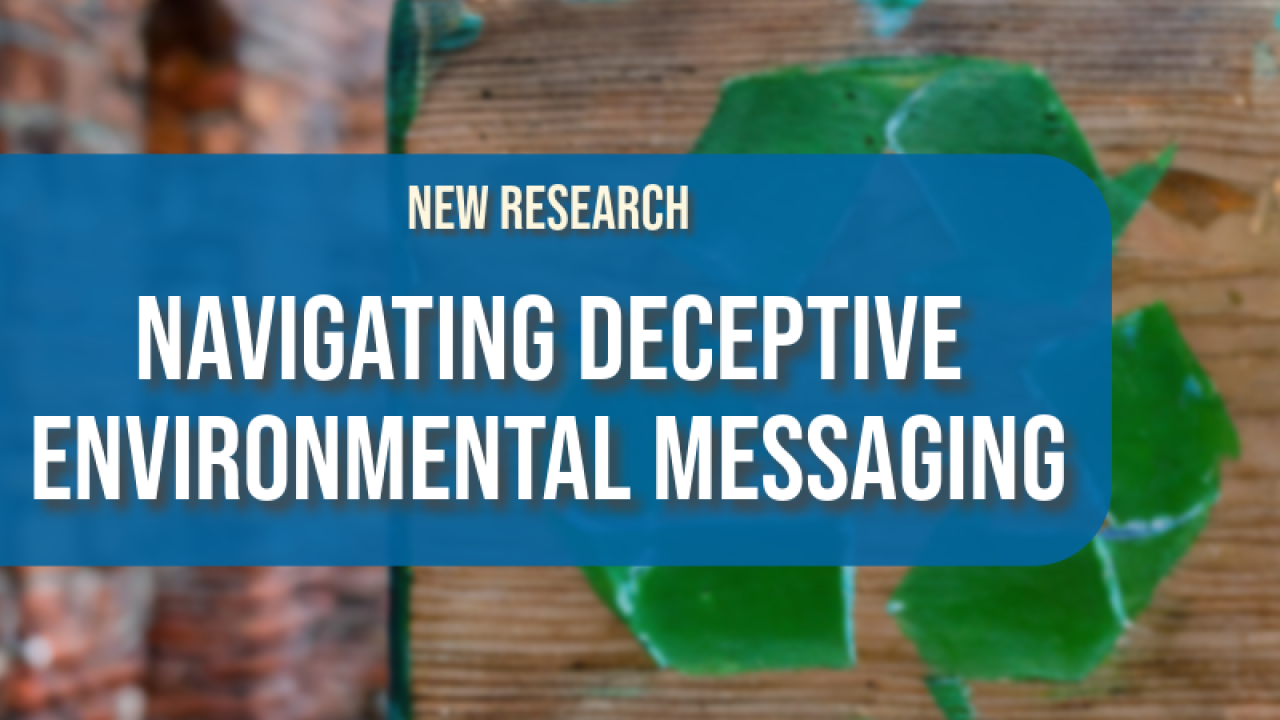February 27, 2024
Navigating deceptive environmental messaging of greenwashing and interventions

By Courtney D. Boman and Matthew S. VanDyke, University of Alabama
In the era of heightened environmental awareness, consumers increasingly seek products aligned with sustainability values. However, amidst genuine efforts, a larger shadow looms – greenwashing. This deceptive practice involves organizations intentionally disseminating misleading information (i.e., disinformation) to create an eco-friendly public image. Our study, funded by the 2022 Arthur W. Page Center’s sustainability call, delves into the nuanced dynamics of greenwashing susceptibility, offering practical insights for practitioners, policymakers, and consumers alike when it comes to developing intervention messaging that can target specific public segments who may be vulnerable to deceptive tactics.
Understanding the landscape of greenwashing
Our study began by dissecting the multifaceted landscape of greenwashing, recognizing it as a pervasive challenge with far-reaching consequences. Drawing on extensive literature, findings identify lacuna publics as key segments within the broader population, each exhibiting unique susceptibility profiles. Lacuna publics denotes an extreme subgroup characterized by intense attitudes and knowledge deficiency on controversial issues, which are at risk for being susceptible to disinformation. From the disinformation-immune to the amplifying publics, this segmentation provides a lens through which to comprehend individuals’ varied attitudes and responses towards greenwashing messages.
Diverse responses across lacuna publics
The study's findings aren't just a collection of observations; they illuminate distinct and noteworthy differences in behavioral intentions across lacuna publics. For example, disinformation-immune individuals (i.e., most likely to actively reject or resist disinformation) exhibited a lower likelihood of purchasing from suspected greenwashing brands after receiving an intervention message, underlining the nuanced nature of attitudes within different segments. Meanwhile, disinformation-amplifying individuals (i.e., moderate risk for accepting disinformation messages) showed a higher likelihood of purchasing post-intervention while also finding the most effective intervention messages, revealing a concrete interplay of susceptibility and consumer behavior.
Inoculation as a shield
Central to the research was exploring inoculation theory as a strategic shield against the persuasive impact of greenwashing. Inoculation messages, like preemptive vaccines, are designed to fortify individuals against potential persuasive attacks. Our study reveals that individuals (regardless of their lacuna segmentation) exposed to prebunking inoculation messages were less likely to succumb to the allure of greenwashing, highlighting the potential of this approach in influencing consumer behavior.
Tailored communication for diverse audiences
Beyond unraveling susceptibility profiles and evaluating inoculation effectiveness, the study advocates for tailoring communication strategies. It recognizes that more than a one-size-fits-all approach is needed in a landscape where diverse lacuna publics navigate greenwashing messages differently. Tailored communication strategies, attuned to each segment’s unique motivations, attitudes, and knowledge levels, emerge as a critical imperative.
Implications for practice
For practitioners and communicators, these findings carry implications that can help guide intervention and education-based messaging. Crafting messages that resonate with the unique characteristics of each lacuna public becomes imperative. The study prompts a reevaluation of communication strategies, advocating for a nuanced and targeted approach that acknowledges the diverse responses stemming from varied susceptibility profiles.
Empowering informed decision-making
Ultimately, we believe this research equips PR professionals and researchers with a heightened awareness of the intricacies surrounding greenwashing susceptibility. This insight allows disseminating strategies to arm consumers with knowledge about the deceptive tactics employed, allowing for more informed choices. For policymakers, the study underscores the need for regulations and monitoring to curtail greenwashing practices and protect consumers from misleading information.
Our study unravels the layers of greenwashing susceptibility, offering actionable insights for navigating this complex terrain. From leveraging inoculation strategies to tailoring communication approaches to address motivation, knowledge, and attitudes, the research contributes to the arsenal for combating deceptive environmental messaging. As consumers become savvier and demand authenticity, the study serves as a valuable resource, guiding stakeholders toward a more transparent and responsible era of corporate communication.
For further information on this study, please email Boman at boman@apr.ua.edu. This project was supported by a 2022 Page/Johnson Legacy Scholar Grant from the Arthur W. Page Center.
